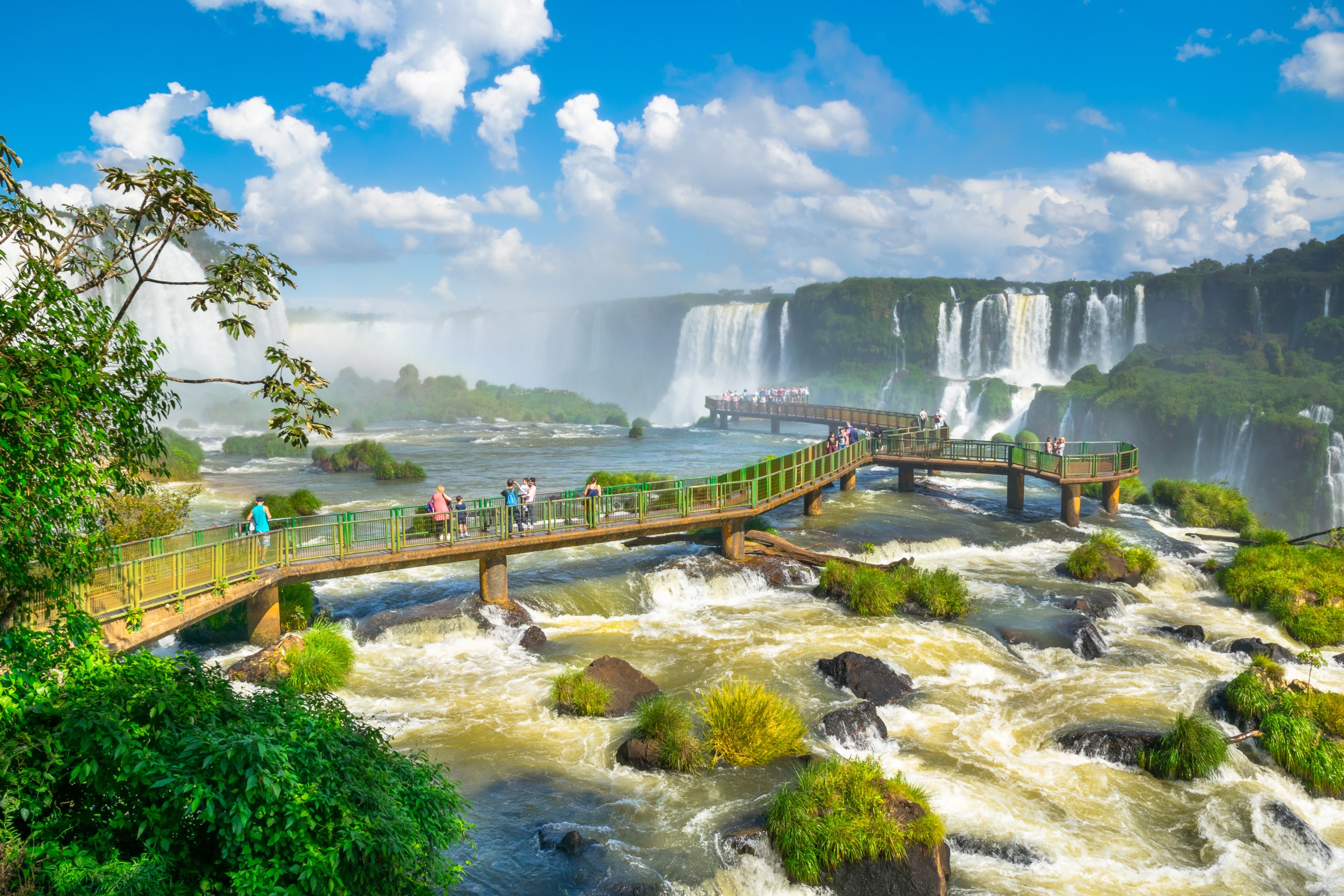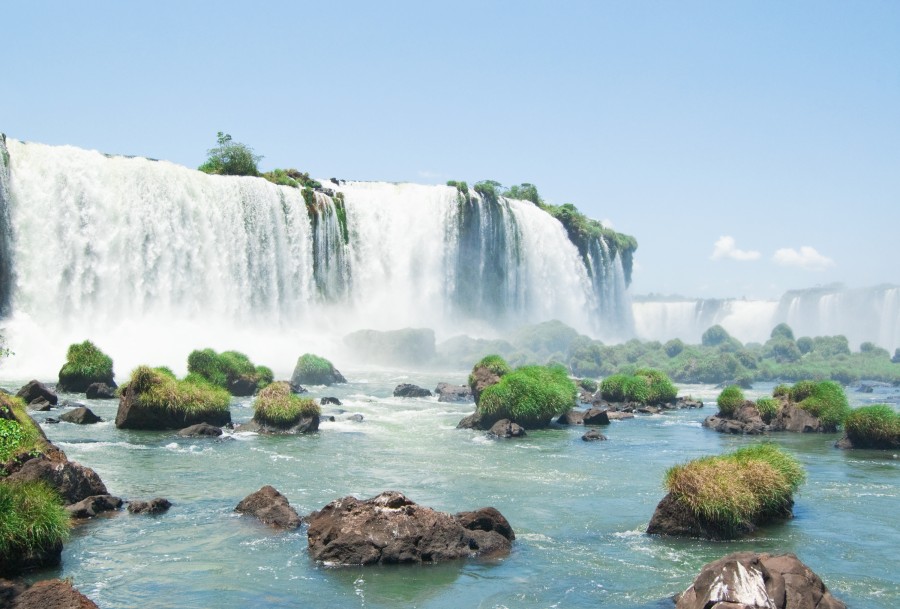
Heavy Rain, Flooding, and Chance of Severe Weather Staring Down the Southern U.S.
January 22, 2024
Posted: October 17, 2022 2:53 pm





Of the many worries people around the world experience these days, climate change tends to fall somewhere within most top ten or five lists of the most worrisome issues, especially lists related to issues happening on a global scale that impact all life.
Good news about the weather brings people joy but also prompts them to make comparisons. The most recent event, the spectacular restoration of the Iguazú Falls in South America, has certainly drawn positive and negative attention.
Read on to learn more about this event and its relation to climate change:
The Iguazú Falls are the byproduct of the Iguazú River cascading over several wide sections of massive, steep cliffs along the borders of Argentina and Brazil in the Iguazú and Iguaçu National Parks found on each country’s respective sides of the falls. Brazil describes them as the Iguaçu Falls rather than the Iguazú Falls. UNESCO declared the parks and falls World Heritage Sites in the mid 1980s. They’re often compared to the stunning Victoria Falls between the African countries of Zambia and Zimbabwe.
The area contains 275 unique waterfalls that flow at approximately 396,258 gallons per second. By Wednesday, October 12, after a tremendous amount of rainfall in the region, water cascaded thunderously down the cliffs at approximately 3.8 million gallons per second or 10 times the normal amount.
Although tourists often visit the area to see the display put on by the waterfalls, local tourist sites that offer the best views, including the famous Brazilian walkway that looks out on the popular Devil’s Throat (Garganta del Diablo) portion of the waterfalls, had to close that day because of concerns about the dangerously high water volume.
Other than the rainfall providing tourists and others with an amazing view of the power of nature, the event matters in the larger global climate sense for many reasons:
The Iguazú Falls’ region is well known for experiencing plenty of precipitation, high temps and humidity throughout the year. March through May, the autumn season, is the driest period it typically ever knows with a few weeks of low or no rainfall. The heaviest rainfall usually occurs during summer between December and February and not in October during spring.
This atypical event followed a separate one in June 2022, during the beginning of the winter season, that destroyed several sections of the Devil’s Throat walkway entirely, damaged more than 400 homes and forced evacuation of approximately 1,200 local residents on the Brazilian side. After that rainfall, the river flowed at 2.6 million gallons per second. Downpours in June have happened in the past. The Iguazú Falls experienced its highest water flow of 12.4 million gallons per second in June 2014.

That said, the region has also increasingly seen drought conditions over the last decade. In 2021, Brazil experienced its worst drought ever over a recorded period of 90 years. The 2020 drought exposed the faces of most of the cliffs when the Iguazú River trickled rather than cascaded down them in few spots. The nearby Paraná River’s height that year suffered a 50-year-low that stranded ships and slowed down hydropower energy production.
Experts agree that all of these events connect locally to deforestation, desertification and the La Niña weather phenomenon. They also connect globally to overall problems related to climate change caused by humans during the Anthropocene Epoch, which marks the period of Earth’s history during which humans have had the greatest impact on all climates and other natural systems.
The Iguazú Falls’ region isn’t the only one to experience atypical weather this year. In September, the United States experienced the deadliest storm since 1935 to hit the Eastern Seaboard. Hurricane Ian bashed the coastline and caused so much high-wind and flooding damage that it’s now considered one of the nation’s top five worst historic storms. Preliminary estimates by insurers and risk analysts place the property damage costs at more than $70 billion. Many experts estimate final costs at hundreds of billions.
On the other hand, many areas throughout the Unites States and world have been gripped by crippling drought conditions. The West Coast of the U.S. has been so badly hobbled by drought that states and the federal government are now paying farmers and others to reduce their water usage. The Colorado River dropped so much that the Lake Mead Reservoir has revealed many glorious and awful secrets, including ancient geologic formations and the bodies of murder victims.
These conditions have moved well beyond the West with more than half of the U.S experiencing severe drought. This past week, the Mississippi River reached its fifth historic-low level. Drought conditions do more than adversely impact agriculture and access to fresh water. The Mississippi River is one off the biggest commercial transport lanes in the country. Barges stranded on the river can hold up traffic from thousands of watercraft, as proven recently with a backup of more than 2,000 vessels. Traffic congestion can exacerbate current, severe, supply-chain problems and the speed at which products reach destinations. These events increase the prices consumers pay in stores and online.
Outside of the U.S., in Italy, for example, historic drought conditions followed by deadly torrential rains, ice melt and flooding show the severity of climate change on peoples, countries and economies. Experts have estimated that Italy’s wine industry alone lost 9% of its production in 2021 to drought. For months this summer, Italians fought some of the worst drought conditions seen in nearly 70 years. Italy’s largest reservoir, the Po River, became bone dry. Yet, in July, they dealt with sudden severe flooding after a glacier melted too quickly. In September, the central part of the country was struck suddenly with a deluge of 16 inches of rain within only a few hours. The people had no warning. Landscapes hardened by drought conditions refused to soak up the water and flood waters tore through areas.
Given events around the world, meteorologists have no reason to doubt that people living and working in or visiting Iguazú National Park, Iguaçu National Park, other areas throughout Argentina and Brazil and the entirety of South America can expect increasingly atypical climate and weather conditions in the months and years ahead. This month’s sudden rainfall and similar events in June are loud warnings about continued local, national and global environmental changes that people must prepare for if they don’t want to experience loss of property or life.
Experts agree that now is the best time to review home insurance plans and flood plain maps. People should consider moving away from areas that are expected to experience more flooding in the future. They can also prepare by learning as much as possible about how to better adapt to drought and flood conditions.
That said, for now, heavy rainfall also means that the Iguazú Falls have rarely been more beautiful. Anyone who has the means and opportunity should take the time to visit and explore the region and enjoy this breathtaking work of nature.

January 21, 2024

January 19, 2024

January 18, 2024